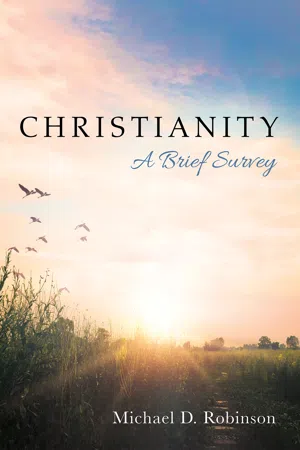![]()
Part One: Christian Foundations
![]()
1
Sacred Text and Sacred History
Christianity is anchored in four important foundations: a sacred text, a sacred history, a sacred person, and a sacred community. In the next two chapters, we explore these four groundworks. At the core of Christianity is the conviction that God has been active in human history, interacting and communicating with human beings. From this divine-human exchange a sacred history or “ordering narrative” has unfolded; this history began in the story of the Hebrew people (also called Israelites and Jews), continued in the person and work of Jesus of Nazareth, and took further shape in the community that grew up around Jesus. In turn, Christians believe that much of this sacred chronicle has been described in the pages of Christian Scriptures, often called the Bible. The Bible is both a written account of and a product of this divine-human interface; therefore, the Bible is both a source for knowledge of God and a catalyst for ongoing divine-human encounters.
For Christians, the apex of sacred history is in the person, life, and deeds of Jesus. In turn, Jesus’ life emerged and was interpreted within the complex cultural context of first-century Palestinian Judaism, which itself was grounded in the ancient sacred story of the Israelites. Further, even within that first-century context, the significance of Jesus—who he was and what he accomplished—was not immediately evident. It certainly was not obvious to his contemporaries, at least not according to the biblical accounts. Some of Jesus’ contemporaries saw him as a blasphemer and his teachings as an aberration of the Hebrew sacred tradition, while others (his followers) saw him as the fulfillment of Jewish religious insights and hopes. Thus, to understand Jesus (and the community that formed around him) requires a basic knowledge of the Jewish tradition out of which Jesus (and Christianity) came, as well as an awareness of the earliest Christian accounts and interpretations of Jesus’ identity and accomplishments.
In this chapter, in the section entitled Sacred History, we explore the core narratives and religious teachings of the Hebrew tradition from which Jesus and Christianity emerged. In many ways, the story of the Israelites is only a portion of the sacred history of Christianity. That history continues in the life and work of Jesus, as well as in the activities of his earliest followers. Still for the sake of convenience, we will refer to the Hebrew story as “the sacred history” and will discuss the story of Jesus and of the community that grew up around him using different headings. Specifically, in Chapter 2, in the section called Sacred Person, we discuss the basic interpretations of Jesus and his significance as assessed by the earliest Christians. In turn, in chapter 2, in the section called Sacred Community, we examine the emergence of the earliest societies that rose up around Jesus, discussing the nature and mission of those groups. Before exploring these topics, however, it will be helpful to say a word about the Bible, for it is largely from that literature that we learn of the sacred history of Israel, of the person and work of Jesus, and of the faith-movement that sprang-forth from Jesus. We will discuss this literature under the title sacred text, to which we now turn.
Sacred Text
The Bible is less a single book than it is a library of books. It contains multiple independent writings composed by numerous authors over a more-than-thousand-year span. Typically, these books are separated into two major groupings: the Old Testament and the New Testament. The Old Testament contains sacred Jewish writings prior to Jesus. The New Testament contains sacred Christian Scriptures that arose within the first hundred years of Jesus’ death. The label “Old Testament” is largely a Christian expression. The term “testament” is from a Latin translation of the Greek word diathēkē, which is perhaps better translated “covenant.” The central idea behind the division of the Christian Bible into the Old and New Testaments is that the Old Testament deals with matters of God’s first covenant (agreement, contract) with the people of Israel, whereas the New Testament deals with God’s new covenant with believers in Jesus Christ (see Exod 19–20; Luke 22:20; 1 Cor 11:23–26; Heb 9:11–15, 10:14–25). Since the Bible is from the ancient world, it is written in the languages of that world. The Old Testament is written primarily in ancient Hebrew; the New Testament is written in first-century Greek.
In recent years, many have contended that using the label “Old Testament” is inappropriate or in bad taste. A preference is to call these materials “the Hebrew Bible.” This certainly is understandable since these writings were produced by the ancient Jewish people and remain today the primary scripture of Judaism. Further, these scriptures are (for the most part) written in the ancient Hebrew language. In this work, I will use the terms “Old Testament” and “Hebrew Bible” synonymously, attempting to honor these writings both as the sacred text of the Jewish tradition and as the foundational scriptures of the Christian tradition.
Canon and Content
While most Christians agree about which writings constitute the New Testament, there is some disagreement about which books should be included in the Old Testament. There are three major divisions of Christians—Roman Catholics, Eastern Orthodo...
